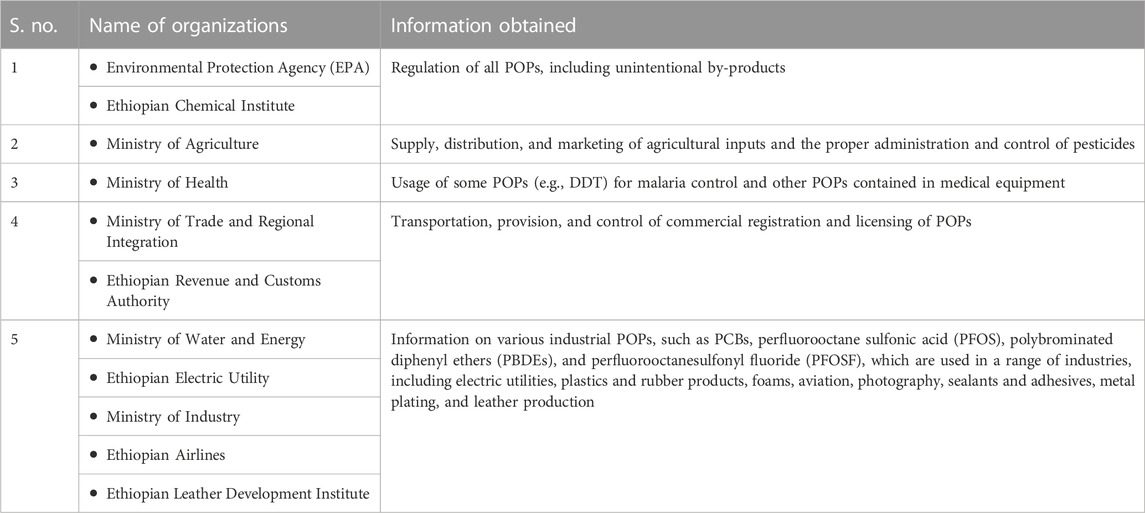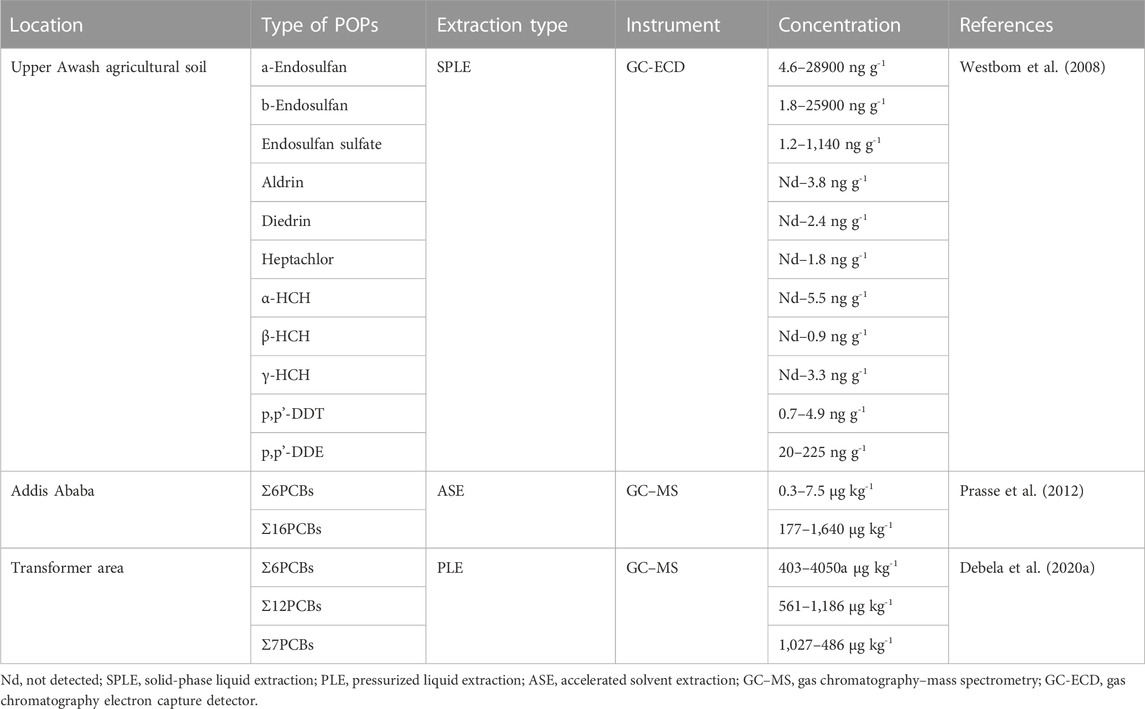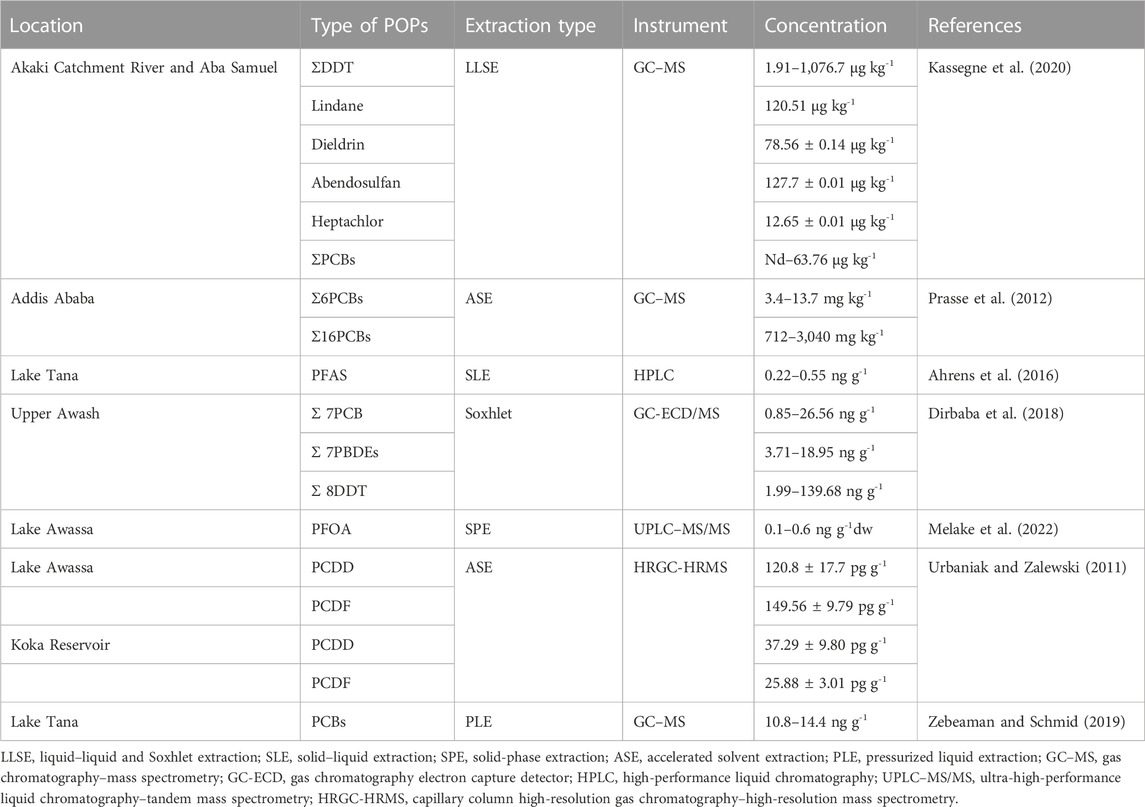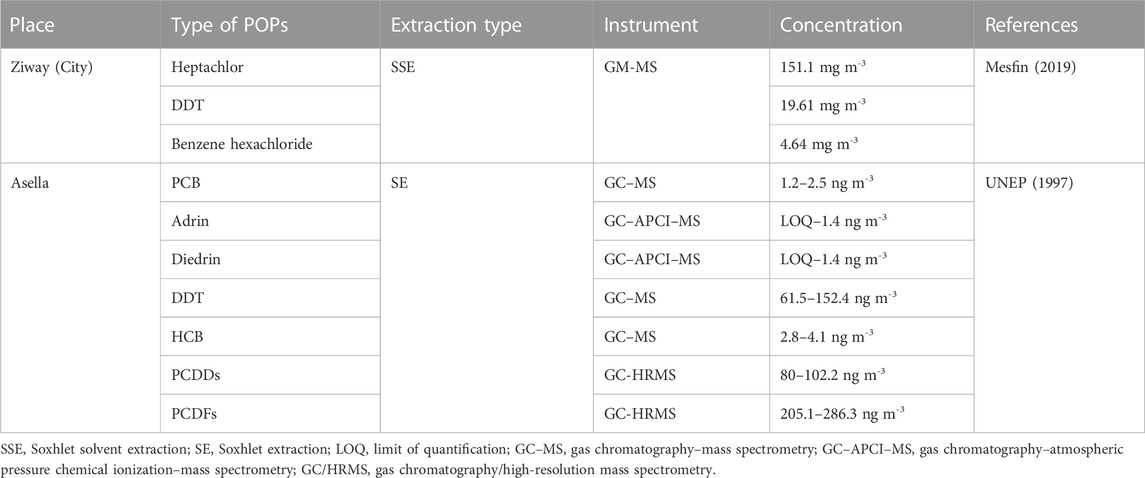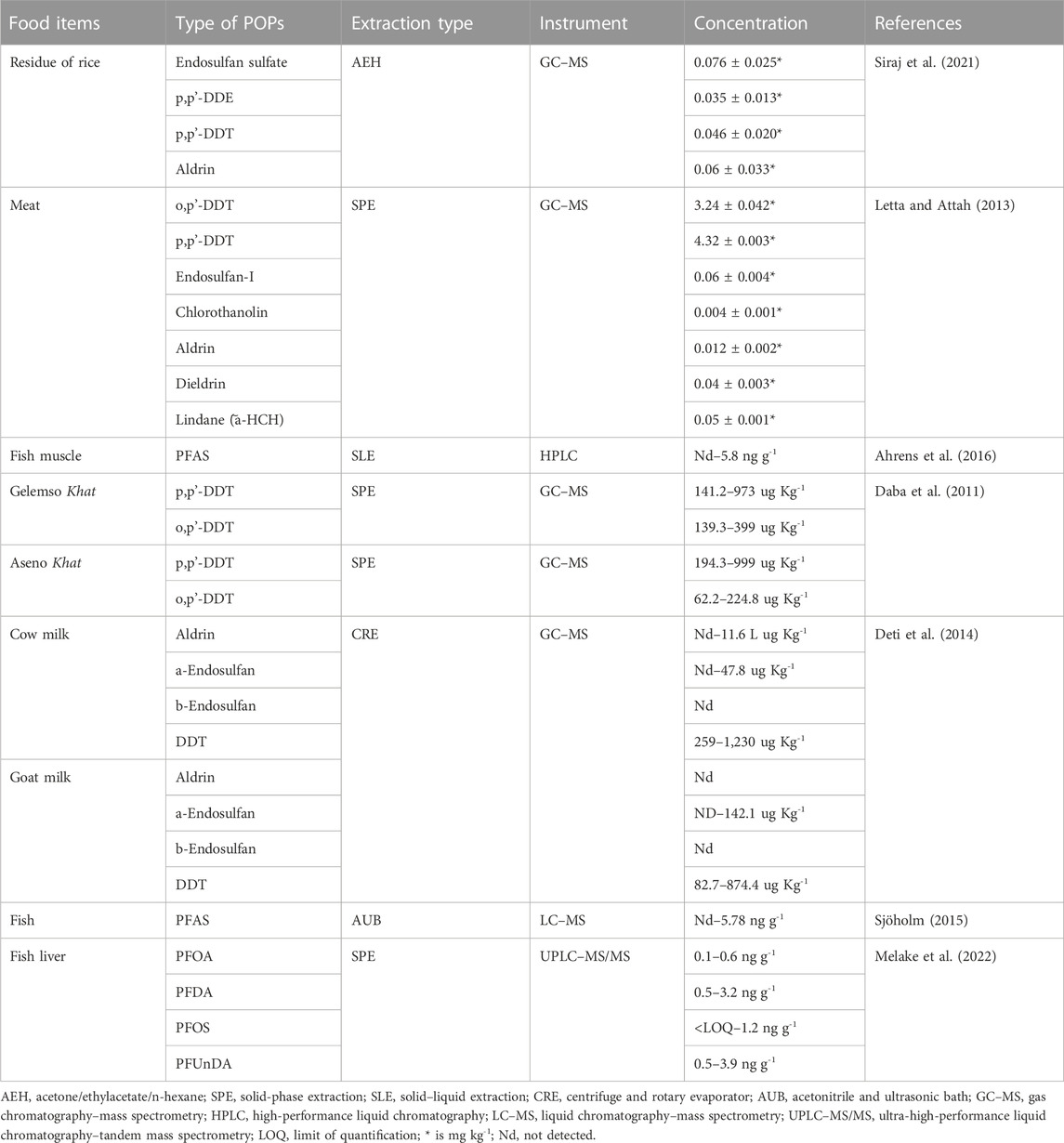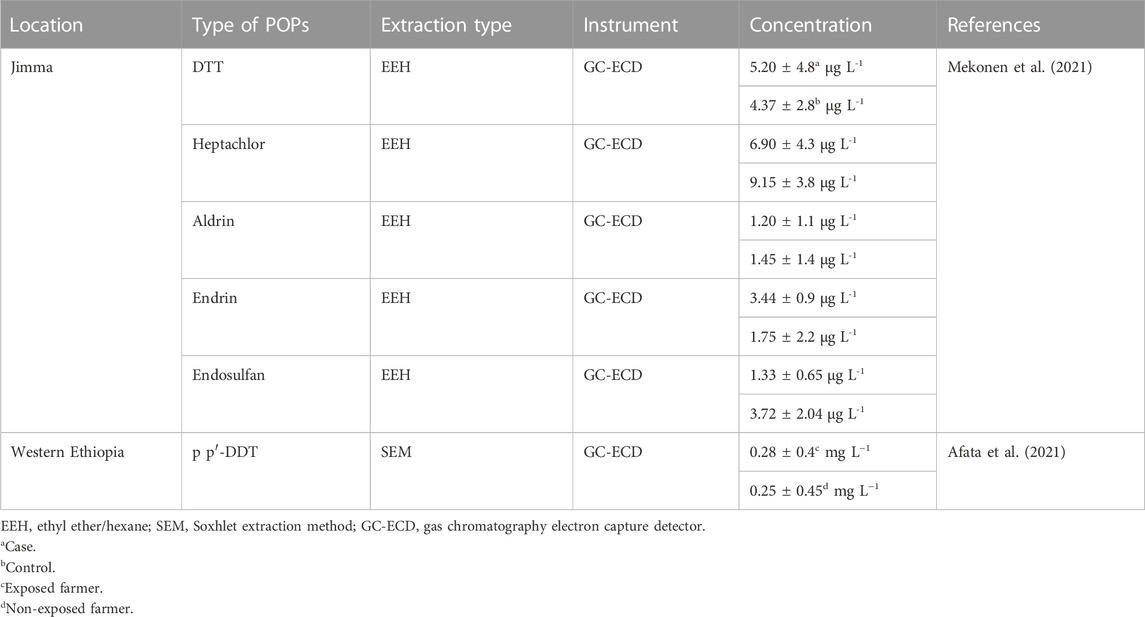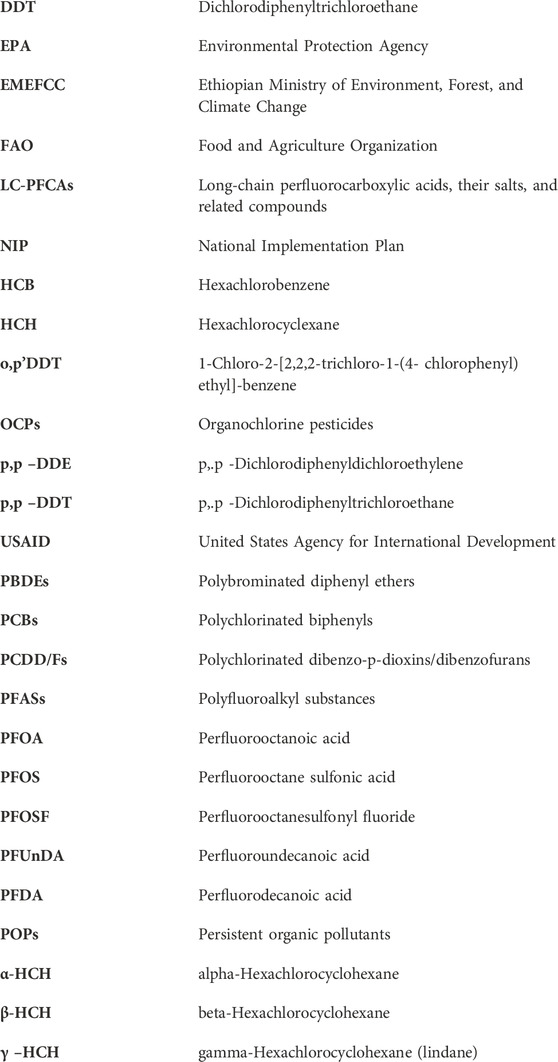- 1Department of Public Health, College of Medicine and Health Sciences, Salale University, Fitche, Ethiopia
- 2School of Civil Engineering, Universiti Sains Malaysia, Nibong Tebal, Malaysia
- 3Department of Environmental Health, College of Medicine and Health Sciences, Wollo University, Dessie, Ethiopia
- 4Adelaide Exposure Science and Health, School of Public Health, University of Adelaide, Adelaide, SA, Australia
Over the years, the chemical market has shown significant growth, but the hazardous impact of chemical use and disposal on the environment and human health is a growing concern. Persistent organic pollutants (POPs) are among the most dangerous chemicals with widespread effects on the environment and living organisms, including humans. This study aimed to assess the current status of POP management and regulatory infrastructure in Ethiopia by collecting information from stakeholders responsible for recording the import, export, use, management, and regulation of POPs both in government and private sectors. Additionally, a comprehensive literature review was conducted using Boolean operators from international databases and libraries. The results indicated that Ethiopia banned the import of pesticides listed under Annex A (i.e., those to be eliminated), except endosulfan, which was imported at a quantity of 199,767 kg lt-1 from 2011 to 2015. There are 2,435 PCB-containing transformers in Ethiopia, of which 2,242 (92%) are currently in use. These transformers and capacitors contain 1,031,661 kg and 1,255 kg of dielectric fluids, respectively. As for Annex B POPs (i.e., those to be restricted), there are between 928,509 kg and 1,383,095 kg of active and obsolete dichlorodiphenyltrichloroethane found in different stores across the country. Ethiopia imported approximately 337,000 kg of products containing perfluorooctane sulfonic acid from 2000 to 2020, with an annual average of 16,850 kg of photographic film, paper, and plates. POPs were also detected in different environmental matrices (soil, waterbodies, sediments, food items, and air) as well as human blood. Despite these findings, regulation and management of POP waste and stockpiles are largely inadequate in Ethiopia. Therefore, it is crucial to improve the monitoring, management, and regulation of POPs in the country. This could be achieved by strengthening the collaboration among different regulatory bodies, harmonizing the fragmented laws on POP management and control, and building institutional capacity.
1 Introduction
Persistent organic pollutants (POPs) refer to a group of chemicals, including industrial chemicals, pesticides, and unintentional by-products, that share common characteristics, such as environmental persistence (Aljerf and AlMasri, 2018; Sathishkumar et al., 2021), bioaccumulation (Weltmeyer et al., 2021), and long-range transport potential. These chemicals are ubiquitous in the environment (Scheringer, 2009; Hageman et al., 2015; Kallenborn et al., 2015), and exposure to them has been linked to significant changes in the human gut microbiome, resulting in toxicity (Popli et al., 2022) as well as an increased risk of type 2 diabetes and hypertension (Hernández-Mariano et al., 2022). Prenatal exposure to POPs has also been associated with an increased risk of developing gestational diabetes in pregnant women (Zhang et al., 2018) and causing cardiometabolic effects on offspring not only during infancy but also up to adolescence (Güil-Oumrait et al., 2021).
The negotiation process for the Stockholm Convention, the main multilateral environmental agreement regulating POPs, started in the 1990s, and it was eventually adopted in 2001, before being enforced in 2004 (Scheringer, 2009, Secretariat of the Stockholm; Convention, 2019a). The convention initially targeted 12 POPs, known as the ‘dirty dozen,’ which included polychlorinated biphenyls (PCBs) and some organochlorine pesticides (OCPs) (Secretariat of the Stockholm Convention, 2019b). However, over the years, the list of restricted compounds has grown (Secretariat of the Stockholm Convention, 2022a), with six additional compounds (Dechlorane Plus, methoxychlor, UV-328, chlorpyrifos, chlorinated paraffins, and long-chain perfluorocarboxylic acids, their salts, and related compounds (LC-PFCAs)) currently under review for inclusion to the list (Secretariat of the Stockholm Convention, 2022b). The Stockholm Convention categorizes POPs into different groups, such as Annex A, B, and C, and mandates that parties take measures to eliminate and restrict the production and use of chemicals listed under Annex A and Annex B, respectively. Annex C chemicals are generally considered unintentional by-products.
The Stockholm Convention has 152 signatories and 186 parties, including Ethiopia, which submitted its first National Implementation Plan (NIP) on POPs in 2006 (EMEFCC, 2006). However, the plan has not been updated despite additional POPs being included in the convention, which puts Ethiopia behind other countries in the region (e.g., Kenya, Burundi, Tanzania, and Seychelles) that have updated their NIPs. Several reviews have been conducted on the POP situation in different countries, focusing on research trends and regulation (Sheriff et al., 2021), environmental levels and human exposure (Minh et al., 2008; Mazlan et al., 2017; Bruce-Vanderpuije et al., 2019; Helou et al., 2019; Olisah et al., 2021; Rezania et al., 2022), sources (Olisah et al., 2021), and levels in fish and food (Mazlan et al., 2017; Uzomah et al., 2021). However, recent information on the POP situation in Ethiopia is lacking. This study seeks to address this gap by providing a comprehensive assessment of the status, management, and regulatory infrastructure (legal, institutional, administrative, and technical) of POPs in Ethiopia. The outcome can be used to develop evidence-based policies and strategies to reduce POP exposure and contamination in Ethiopia.
2 Methodology
2.1 Data collection
The study used two methods of data collection. First, a checklist was developed to obtain information on the use, import, export, releases, alternative future use of POPs, institutional collaboration, and management of POP stockpiles. The data were collected from organizations responsible for recording the import, export, use, management, and regulation of POPs both in private and government sectors. Table 1 presents the list of these organizations and the nature of the information collected from each.
Second, a comprehensive literature review on POPs in Ethiopia was conducted. Scopus, Science Direct, Web of Science, Google Scholar, and PubMed were searched using Boolean operators and keywords, such as Stockholm Convention, National Implementation Plan, and Ethiopia, to locate published articles. The search was conducted without any time restrictions to find relevant studies on POPs. The review included studies conducted in Ethiopia that reported on the level of POPs in environmental media, as well as articles published in scientific journals and gray literature. All papers and reports were critically evaluated based on their title, abstract, and full-text, and only full-text articles written in English were considered.
2.2 Data analysis
The data were transferred to and analyzed using STATA software (StataCorp. 2021. Stata Statistical Software: Release 17. College Station, TX: StataCorp LLC). The STATA software was also used to generate maps that illustrate the storage and regional distribution of chemicals.
3 Results and discussion
3.1 Annex A pesticides
Based on an inventory conducted by the Ethiopian Revenue and Customs Authority since 2000, Ethiopia has not yet produced any pesticide listed under Annex A. Moreover, with the exception of endosulfan, the country has not imported any old or new Annex A pesticide. Therefore, this study solely focuses on endosulfan, which is utilized in high quantities for controlling cotton pests in Ethiopia’s agricultural sector. Table 2 shows that approximately 200,000 L of endosulfan were imported between 2015 and 2020, although there are no data available for 2019. Farming activities may lead to the direct release of endosulfan to the environment. Apart from endosulfan, the first NIP in 2006 identified four types of obsolete Annex A pesticides: aldrin, dieldrin, heptachlor, and chlordane, with respective quantities of 2,159, 2,822, 7,043, and 2,591 kg Lt-1 (EMEFCC, 2006). In the northern region of Ethiopia, stockpiles of aldrin, heptachlor, and dieldrin were 1,398, 1,523, and 621 kg, respectively (Haylamicheal and Dalvie, 2009b; Debela et al., 2020b).
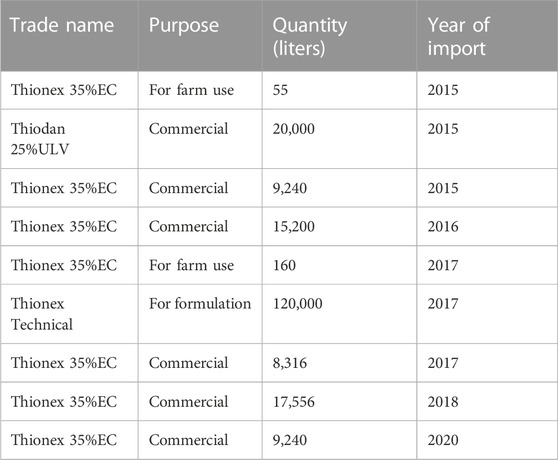
TABLE 2. Imported quantities of endosulfan (trade name—Thionex) from 2015 to 2020 in Ethiopia (source: the Ethiopia Revenues and Customs Authority).
3.2 Annex A PCBs
The data provided by the Ethiopian Electric Utility reveal that there are 2,435 transformers in Ethiopia that contain PCBs, out of which 2,242 are currently in use. In contrast, the 2006 NIP documented 2,505 PCBs containing electric transformers, and nearly 2,415 of them were in use (EMEFCC, 2006). The difference in these two reports (−70 in the first) could be due to the initial inventory’s incompleteness in terms of assessing suspected locations. The total quantities of suspected PCB-containing dielectric fluids in these transformers and capacitors are 1,031,661 kg and 1,255 kg, respectively. The 2006 NIP reported that the weight of PCB-containing dielectric fluids was 1,181,667 kg and 1,255 kg for transformers and capacitors, respectively (EMEFCC, 2006). For capacitors, the weight reported in 2006 and in the current assessment remains unchanged. The slight variation in the weight of transformer dielectric fluid implies that the responsible bodies either did not update the data or the fluids were not disposed-off due to limited capacity. It is also essential to note that the time/year when the Ethiopian Electric Utility updated its PCB inventory for this study remains unclear.
Western Ethiopia has the highest number of PCB-containing transformers, with 497, followed by the southern Addis Ababa Region, with 357 (Figure 1 and Supplementary Table S1). This is in contrast to the 2006 NIP report, which reported the highest number of PCB-containing transformers in the Central Region as 674, followed by 309 in Western Ethiopia (EMEFCC, 2006). The Ethiopian Electric Utility reports that some PCB-containing transformers are currently in use and are kept in workshops for maintenance, while others have been discarded. All PCB-containing transformers were manufactured before 1989, and there is a workshop for PCB transformer maintenance in the Central Region.
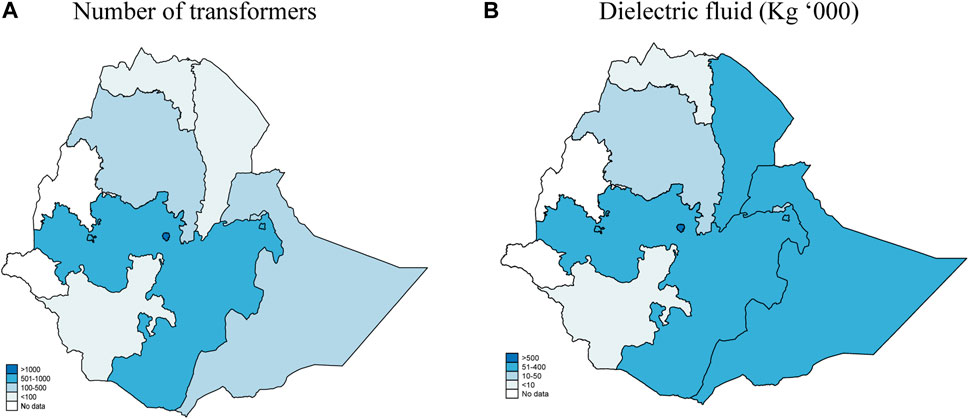
FIGURE 1. (A) Number of transformers and (B) dielectric fluid (Kg ‘000) in different regions of Ethiopia (detailed reports are indicated in Supplementary Table S1; source: the Ethiopian EPA and Ethiopian Electric Utility).
The Ethiopian EPA has identified three current PCB hotspot areas across the country: Gofa central warehouse, Kotobe auxiliary maintenance workshop, and METEC-EPEI (a newly established transformer refurbishing and manufacturing factory). Gofa central warehouse was the only hotspot identified in the 2006 NIP (EMEFCC, 2006). Discarded transformers, suspected to contain PCB oil, were stored in steel tankers at the Kotobe maintenance workshop (Debela et al., 2020a; Debela et al., 2021). Transformers, capacitors, and PCB-suspected dielectric fluids and oil are located in highly populated areas in the cities. These materials are stored in an unlocked fenced area. According to the information obtained from the Ethiopian Electric Utility, 11,232 L of dielectric fluid and oil were sold to a lime-producing factory in 2016, which used it as an energy source for lime processing.
3.3 Annex B pesticides
DDT was formulated in Ethiopia by the Adami Tulu Pesticide Processing Share Company for the purpose of controlling vector-borne diseases, such as malaria. However, there are no available data on the importation and exportation of DDT. A previous assessment reported 160, 573 Kg Lt-1 active and 55, 720 Kg Lt-1 obsolete DDT in different storage sites of the country (EMEFCC, 2006) (Figure 2, Figure 3). According to the Ministry of Agriculture, there are a total of 1,383,095 kg of both active and obsolete DDT in Ethiopia, whereas data from the Ethiopian EPA indicate that only 928,509.3 kg are present (Supplementary Table S2). It could be seen that the DDT data provided by these two government institutions that are in charge of pesticides were not the same. This discrepancy highlights the need for greater collaboration among government ministries, departments, and agencies. The Adami Tulu Pesticide Processing Share Company warehouse currently stores 454,586 kg of DDT, and there are approximately 460 sites suspected to be contaminated with DDT. Production of DDT for disease vector control was permitted under the Stockholm Convention (UNEP, 1997); however, studies have shown that disease vectors in Ethiopia are developing resistance to DDT (Alemayehu et al., 2017; Demissew et al., 2022). As a result, the Ministry of Health has been using alternative non-POP chemicals, such as piperonyl butoxide, pyrethroid, and carbamates, since 2018 (Gari and Lindtjorn, 2018). Despite being officially discontinued for vector control, there are reports of smallholder farmers purchasing DDT from the illegal market for other purposes. This has resulted in the unintentional release of DDT into the environment due to improper storage and illegal use (Mekonen et al., 2017; Afata et al., 2022; Endalew et al., 2022).
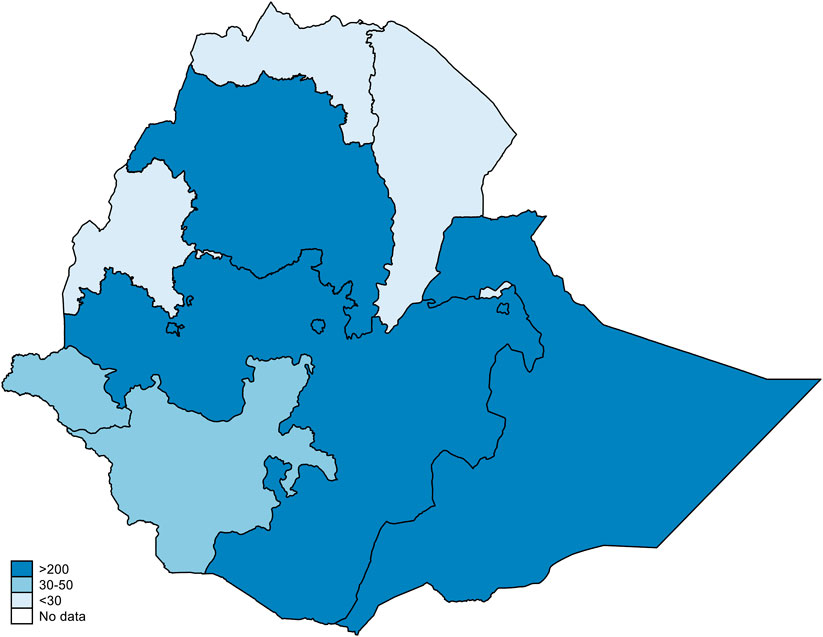
FIGURE 2. DDT amount (Kg ‘000) in different regions of Ethiopia (detailed reports are indicated in Supplementary Table S2; source: the Ethiopian EPA).
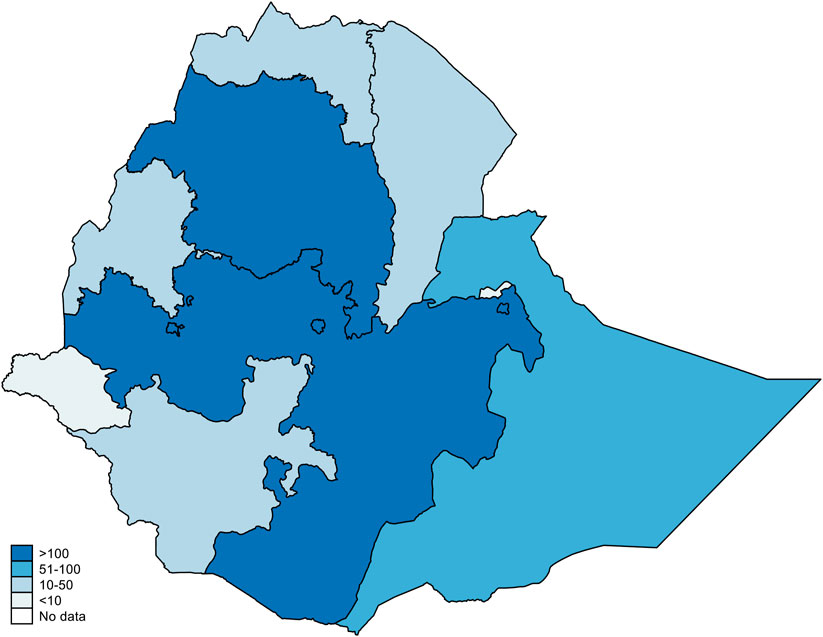
FIGURE 3. Number of DDT stores in different regions of Ethiopia (detailed reports are indicated in Supplementary Table S1; source: the Ethiopian EPA).
3.4 Annex B perfluorooctane sulfonic acid
The information on the production and use of PFOS and its related substances and articles suspected for PFOS were collected from Ethiopian Airlines, the Ministry of Trade and Regional Integration, the Ministry of Industry, and the Ethiopia Chemical Institute. PFOS is used in different sectors, including photo imaging, metal plating, mining, plastic and rubber products, textile, leather, synthetic carpet, pulp and paper, paints, varnishes, electric and electronic parts, firefighting foam, hydraulic fluids, and others. From 2000 to 2020, Ethiopia imported approximately 337,000 kg of PFOS-containing products, including photographic film, paper, and plates, with an annual average imported quantity of 16,850 kg. According to the Ethiopian EPA, emission of PFOS from these sectors is 2.2 kg per year (Supplementary Table S1 and Supplementary Table S2). METECH Engineering, the Ethiopian Air Force, and Ethiopian Airlines are among the large companies that operate their own maintenance workshops and utilize PFOS for plating purposes. However, the Ministry of Mines, Petroleum, and Natural Gas has reported that there is no mining industry in Ethiopia that uses PFOS. Similarly, the respective industry bodies of plastic and rubber production, textile, and leather manufacturing have reported that they do not use PFOS or PFOS-containing products in their operations.
Other potential sources of PFOS in Ethiopia may include imported carpets and pulp and paper production. To estimate the potential use of PFOS in imported carpets, data on the total amount of imported synthetic carpets were collected. Between 2000 and 2020, Ethiopia imported 105,764 kg of synthetic carpets, with an average annual import quantity of 5,288 kg. This indicates a potential consumption of 3.3–33.6 kg of PFOS per year, assuming that all imported carpets contain PFOS. However, the pulping industry in Ethiopia is still in its infancy and not yet at the stage of using PFOS chemicals. Most of the paper used in Ethiopia is imported, and some paper plants use recycled paper and cartons for pulp production. Packed food materials are also imported, which may contain PFOS. These packing materials are typically disposed-off as garbage in open fields and dump sites, which can lead to the entry of PFOS-containing materials into the environment.
Although Ethiopia’s aviation hydraulic fluid and firefighting foam industries are not using PFOS, they may use PFOS derivative chemicals. For example, hydraulic fluid Skydrol LD4 contains a minimal amount of PFOS. However, these industries do not have any stockpile of PFOS-containing waste under their control. As municipal solid waste in Ethiopia is collected and dumped without segregation (Akele and Tarekegn, 2017; Amare et al., 2022; Lewoyehu et al., 2022) and industries discharge their wastewater with little or no treatment to the surrounding river, PFOS-containing waste materials from industries are likely to cause environmental contamination (Ahrens et al., 2016).
3.5 Polybrominated diphenyl ethers
Ethiopia has imported PBDEs through electrical and electronic equipment and in-vehicle products. The country has experienced a rapid transformation in Information and Communication Technology (ICT) in recent years, resulting in the importation of computers, mobile phones, and TV sets from developed countries. This has contributed to the increasing amount of electronic waste. There is only one TV assembly company in Ethiopia, and it uses PBDEs.
3.6 Annex C POPs
There are no reliable data on the status of other POPs in Ethiopia. However, the Ethiopian EPA believes that there is unintentional production of Annex C POP chemicals from different categories of sources, such as uncontrolled combustion process of waste incineration, metal and mineral production, transport, power generation, and household heating with biomass and charcoal. During data collection, we found that the level of awareness concerning unintentional POPs among government officials was very low.
3.7 POP disposal facilities in Ethiopia
In Ethiopia, there is no dedicated chemical disposal facility, potentially leading to the accumulation of chemicals in the county. Except for POP pesticides, there have been no efforts to dispose-off other POP chemicals at the time of this assessment. In 2015, various donors and/or partners disposed-off 1,502, 1,093, and 450 tons of chemicals containing 25%, 10%, and 2% POP pesticides, respectively. Furthermore, the United States Agency for International Development (USAID) recently disposed-off 85 tons of DDT as well as 15 tons of DDT-contaminated packing cartons. The Enkoken company in Finland disposed-off 1,511 tons of obsolete pesticides from 220 stores in collaboration with the Food and Agriculture Organization (FAO) and the Ministry of Agriculture between 2000 and 2003 (Haylamicheal and Dalvie, 2009b; Debela et al., 2020b). In addition, Veolia Environmental Services in England removed 1,000 tons of obsolete pesticides during the second phase from 2006 to 2007 (Haylamicheal and Dalvie, 2009a). In 2015, the African Stockpile Project and USAID also disposed-off 3,050,000 kg of DDT.
3.8 POP-contaminated sites in Ethiopia
In the current study, there are no data and figures on POP-contaminated sites in Ethiopia. In the 2006 NIP, 220 contaminated stores and sites were identified across the country. It consisted of 178 contaminated stores (where 41 stores were contaminated by spilled chemicals from the store), 23 burial sites, and 19 open-container stores (EMEFCC, 2006), with the Oromia region having the highest number (102) of contaminated sites.
3.9 Monitoring of POPs in environmental matrices and human blood
This section presents POP concentrations in different environmental matrices, such as soil (Table 3), waterbodies (Table 4), sediments (Table 5), food items (Table 6), and air (Table 7), as well as human blood (Table 8), from different locations in Ethiopia.
3.9.1 Soil
Soil from agricultural land, urban areas, and industrial areas is identified as a major source of organic pollutants, including pesticides (DDT, aldrin, dieldrin, heptachlor, and others) and PCBs (dioxin and non-dioxin) (Table 3) in Ethiopia. A study performed in a transformer workshop and dumpsite in Addis Ababa industrial soil found that PCB levels in the soil ranged from 1.027 to 4.862 mg kg-1 and dioxin-like (DL) Σ12PCBs ranged from 1.6036 to 0.56128 mg kg−1, while non-dioxin-like (NDL) Σ6PCBs ranged from 0.166 to 4.5 mg kg−1 (Debela et al., 2020a). In another study, slight PCB levels in the urban soil of Addis Ababa Σ 16PCB ranged from 0.4 to 18.5 μg kg −1 (Prasse et al., 2012).
In the upper Awash agricultural soil, different POP pesticides, such as endosulfan derivative, aldrin, dieldrin, DDT derivative, and heptachlor, were also detected (Westbom et al., 2008). The highest levels of endosulfan were found in a concentration range of 4.6–28,900 ng g-1. The concentration of PCBs in an urban area is lower than in an industrial area. For the past 40 years, the industrial area has been used for PCB maintenance and disposal. Furthermore, in Ethiopia, eight regions have been identified as potentially contaminated by PCBs, and in all areas, PCB-containing equipment is kept in open filled storage (EMEFCC, 2006).
3.9.2 Water
Four studies investigating the presence of POPs in lakes and rivers were identified. POPs, such as organochlorine pesticides, PCBs, polyfluoroalkyl substances (PFASs), and PFOS, have been found in the Akaki River, Lake Awassa (Hawassa), Lake Tana, and Lake Ziway in recent studies (Table 4). In the Akaki River, the concentrations of ƩDDTs were in the range of 5.33–30.58 ng L-1, which is higher than other POP chemicals (PCBs, PFASs, and PFOS) detected in the lakes of Tana, Ziway, and Awassa. The Akaki River is a river that drains across the capital city (Addis Ababa) and has the potential to be contaminated by different pollutants (Kassegne et al., 2020). The detection of POPs in waterbodies may eventually lead to human exposure through different routes.
3.9.3 Sediment
Water is one of the primary transport channels for substances with hydrophilic functions, such as POPs, whereas sediments typically serve as repositories for these substances because they also have hydrophobic functionalities (Ssebugere et al., 2020). Most POPs have been detected in sediments. According to Kassegne et al. (2020), DDT was the most prevalent pesticide found in all sediment samples collected from the Akaki Catchment River and Aba Samuel (Table 5). DDT concentrations ranged from 1.91 to 1,076.73 g kg-1. In addition, other OCPs were detected in this study area. PCBs have been detected in Addis Ababa urban sediment (Σ16 PCBs ranged from 712 to 3,040 mg kg-1), which is higher than studies conducted by other authors in the sediment of the upper Awash and Lake Tana (Table 4). PCDD and PCDF have also been detected in Lake Tana and the Koka Reservoir. Sediment from Lake Tana has higher concentrations of both PCDF and PCDF than that from Koka Reservoir. PFOA was also detected in Awassa Lake and ranged from 0.1 to 0.6 ng g-1 dw (Ahrens et al., 2016).
3.9.4 Air
The literature on the levels of POPs in the air in Ethiopia is very limited. To date, only two studies have investigated the occurrence of organochlorines in the air. However, the available data show that the levels of POP chemicals are low and vary widely among the two identified study locations. In Ziway, three POPs, namely, heptachlor, DDT, and benzene hexachloride, were determined with average concentrations of 151.1, 19.6, and 4.64 mg m-3, respectively (Table 6). The reports are higher than the study findings conducted by UNEP in Asella City, which found that PCDFs are the predominant OC in Assela City and ranged from 205.1 to 286.3 ng m-3. Ziway is a place where a large number of pesticides are manufactured and stored at the country level.
3.9.5 Food items
POP pesticides and PFOS and its derivatives have been detected in different food items, such as in the residue of rice (Mekonen et al., 2017), cattle meat (Letta and Attah, 2013), fish, fish liver and muscles (Sjöholm, 2015; Ahrens et al., 2016; Melake et al., 2022), khat (Daba et al., 2011), and cow and goat milk (Deti et al., 2014) (Table 7).
3.9.6 Human serum
Samples from blood serum can be used as a marker to monitor human exposure to organic pollutants. In a study conducted in Western Ethiopia, small-scale farmers who were exposed and non-exposed to these pollutants were examined. The blood samples of exposed small-scale farmers showed the highest mean concentrations of p,p'-DDT (0.28 ± 0.4 mg L−1), with high levels of p,p'-DDE, p,p'-DDT, and heptachlor also identified (Afata et al., 2021).
3.10 Weaknesses of regulatory and non-regulatory measures for chemical management in Ethiopia
Except for the proclamation aiming at controlling and regulating pesticides, no legislation specifically addresses other POP chemicals in Ethiopia (Ministry of Agriculture, 2010). As this could be considered a clear gap, it is important to have specific legislation on the management of other POP chemicals. In addition, there is weak coordination among and within responsible institutions. This is a concern in Ethiopia when it comes to the implementation of regulatory measures in chemical management (Akele and Tarekegn, 2017). For instance, there is no active collaboration among the Ministry of Agriculture, the Customs and Revenue Authority, and the EPA. The existing institutional framework does not have a way for coordination because there is no strong line of communication and information sharing among the responsible regulatory bodies. There is a challenge in handling contraband and adulteration, and the shortage of inspectors and vehicles for monitoring purposes bedevils the adequate control of POP chemicals (Debela et al., 2020b). There is also no structure and practice of information exchange on the movement or management of POP chemicals with the customs authority, different ministers, and industries.
Data on chemicals and their safety are available from a variety of governmental and non-governmental organizations, including the ministries of agriculture, trade and industry, customs, and mines and energy. The available information on chemicals in Ethiopia is not systematically organized and easily accessible despite the fact that some institutions have country-wide data on certain chemicals. There is a lack of information on industries suspected of using POP chemicals, their production levels, and the estimated or modeled amount of such chemicals released into the environment.
The current laws related to the management and control of POPs in Ethiopia are unclear, especially in terms of the roles and responsibilities of the relevant organizations. Various government offices have their own regulations concerning the chemicals originating from their respective sectors. Moreover, there are no laws regulating the manufacturing, importing, handling, transport, storage, or disposal of hazardous chemicals, whether industrial or otherwise. Currently, legal frameworks to address these issues are either under development or pending adoption.
3.11 Gaps in institutional capacity
The overall technical infrastructure concerning chemical management within the country is very weak. Industries dealing with chemicals do not have the required experts for the handling of chemicals, and professionals are not well versed with the knowledge and skills that are required for dealing with chemicals. In addition, chemicals are not properly labeled (Ejigu and Mekonnen, 2005; Mequanint et al., 2019; Debela et al., 2020b).
4 Conclusion
This study provides an overview of the status of POPs in Ethiopia by gathering data from various governmental and private institutions involved in the use or regulation of POPs in the country. The findings indicate a significant accumulation of Annex A, B, and C POPs, such as PCBs from electric transformers and POP pesticides in Ethiopia. Notably, the review of the existing literature demonstrates that various environmental matrices, including soil, waterbodies, sediments, food items, and air, as well as human blood, have substantial levels of different POPs. This study has identified several regulatory and non-regulatory gaps in chemical management in the country. Specifically, there is insufficient information available on various POP pollutants, except for endosulfan, at the national level, and no legislation directly addresses other POP chemicals except the pesticide proclamation. Therefore, it is crucial to have specific legislation targeted toward the management of POP chemicals in Ethiopia, achieved by enhancing collaboration and coordination among different regulatory bodies, harmonizing fragmented laws on POP management and control, and building institutional capacity.
Author contributions
SAD, IS, and MG were involved in conceptualization and data Curation; SAD, IS, CD, YT, DB, and MG wrote the original draft, reviewed and edited the manuscript. All authors contributed to the article and approved the submitted version.
Acknowledgments
The authors acknowledge both government and private organizations for all their genuine support. They are also grateful to the managers of the aforementioned institutions for their cooperation.
Conflict of interest
The authors declare that the research was conducted in the absence of any commercial or financial relationships that could be construed as a potential conflict of interest.
Publisher’s note
All claims expressed in this article are solely those of the authors and do not necessarily represent those of their affiliated organizations, or those of the publisher, the editors, and the reviewers. Any product that may be evaluated in this article, or claim that may be made by its manufacturer, is not guaranteed or endorsed by the publisher.
Supplementary material
The supplementary material for this article can be found online at: https://www.frontiersin.org/articles/10.3389/fenvs.2023.1182048/full#supplementary-material
References
Afata, T. N., Mekonen, S., Shekelifa, M., and Tucho, G. T. (2022). Prevalence of pesticide use and occupational exposure among small-scale farmers in western Ethiopia. Environ. Health Insights 16, 117863022110729. doi:10.1177/11786302211072950
Afata, T. N., Mekonen, S., and Tucho, G. T. (2021). Evaluating the level of pesticides in the blood of small-scale farmers and its associated risk factors in western Ethiopia. Environ. Health Insights 15, 117863022110436. doi:10.1177/11786302211043660
Agriculture, M. O. (2010). Pesticide registration and control proclamation No. 674/2010. Addis Ababa: Federal Negarit Gazeta.
Ahrens, L., Gashaw, H., Sjöholm, M., Gebrehiwot, S. G., Getahun, A., Derbe, E., et al. (2016). Poly-and perfluoroalkylated substances (PFASs) in water, sediment and fish muscle tissue from Lake Tana, Ethiopia and implications for human exposure. Chemosphere 165, 352–357. doi:10.1016/j.chemosphere.2016.09.007
Akele, E. S., and Tarekegn, M. M. (2017). Assessment of dioxin and furan emission levels and management practices in Addis Ababa, Ethiopia. J. Health Pollut. 7, 85–94. doi:10.5696/2156-9614-7.15.85
Alemayehu, E., Asale, A., Eba, K., Getahun, K., Tushune, K., Bryon, A., et al. (2017). Mapping insecticide resistance and characterization of resistance mechanisms in Anopheles arabiensis (Diptera: Culicidae) in Ethiopia. Parasit. Vectors 10, 407. doi:10.1186/s13071-017-2342-y
Aljerf, L., and Almasri, N. (2018). Persistence and bioaccumulation of persistent organic pollutants (POPs) in the soil and aquatic ecosystems: Syrian frontiers in ecology and environment. Sustain. Environ. 3, 358–386. doi:10.22158/se.v3n4p358
Amare, N., Al-Bhadly, O., Birhan, M., Sulaiman Hamid, S., and Mohamad, A. A. H. (2022). The practices of solid waste utility and thriving conditions of logistics (a case of tepi town): A study to treat the healthy environment. J. Environ. Public Health 2022, 1–5. doi:10.1155/2022/8391616
Bruce-Vanderpuije, P., Megson, D., Reiner, E. J., Bradley, L., Adu-Kumi, S., and Gardella JR, J. A. (2019). The state of POPs in Ghana-A review on persistent organic pollutants: Environmental and human exposure. Environ. Pollut. 245, 331–342. doi:10.1016/j.envpol.2018.10.107
CONVENTION 2022b. Chemicals proposed for listing under the Convention. Available athttp://chm.pops.int/TheConvention/ThePOPs/ChemicalsProposedforListing/tabid/2510/Default.aspx.
CONVENTION (2019a). History of the negotiations of the Stockholm convention. Available at http://www.pops.int/TheConvention/Overview/History/Overview/tabid/3549/Default.aspx.
CONVENTION (2019b). The 12 initial POPs under the Stockholm convention. Available fromhttp://www.pops.int/TheConvention/ThePOPs/The12InitialPOPs/tabid/296/Default.aspx.
CONVENTION (2022a). The new POPs under the Stockholm convention. Available athttp://chm.pops.int/TheConvention/ThePOPs/TheNewPOPs/tabid/2511/Default.aspx.
Daba, D., Hymete, A., Bekhit, A. A., Mohamed, A. M., and Bekhit Ael, D. (2011). Multi residue analysis of pesticides in wheat and khat collected from different regions of Ethiopia. Bull. Environ. Contam. Toxicol. 86, 336–341. doi:10.1007/s00128-011-0207-1
Debela, S. A., Sheriff, I., Debela, E. A., Sesay, M. T., Tolcha, A., and Tengbe, M. S. (2021). Assessment of perceptions and cancer risks of workers at a polychlorinated biphenyl-contaminated hotspot in Ethiopia. J. Health Pollut. 11, 210609. doi:10.5696/2156-9614-11.30.210609
Debela, S. A., Sheriff, I., Wu, J., Hua, Q., Zhang, Y., and Dibaba, A. K. (2020a). Occurrences, distribution of PCBs in urban soil and management of old transformers dumpsite in Addis Ababa, Ethiopia. Sci. Afr. 8, e00329. doi:10.1016/j.sciaf.2020.e00329
Debela, S. A., Wu, J., Chen, X., and Zhang, Y. (2020b). Stock status, urban public perception, and health risk assessment of obsolete pesticide in Northern Ethiopia. Environ. Sci. Pollut. Res. Int. 27, 25837–25847. doi:10.1007/s11356-019-05694-x
Demissew, A., Animut, A., Kibret, S., Tsegaye, A., Hawaria, D., Degefa, T., et al. (2022). Evidence of pyrethroid resistance in Anopheles amharicus and Anopheles arabiensis from Arjo-Didessa irrigation scheme, Ethiopia. PLoS One 17, e0261713. doi:10.1371/journal.pone.0261713
Deti, H., Hymete, A., Bekhit, A. A., Mohamed, A. M., and Bekhit Ael, D. (2014). Persistent organochlorine pesticides residues in cow and goat milks collected from different regions of Ethiopia. Chemosphere 106, 70–74. doi:10.1016/j.chemosphere.2014.02.012
Dirbaba, N. B., Li, S., Wu, H., Yan, X., and Wang, J. (2018). Organochlorine pesticides, polybrominated diphenyl ethers and polychlorinated biphenyls in surficial sediments of the Awash River Basin, Ethiopia. PLoS One 13, e0205026. doi:10.1371/journal.pone.0205026
Ejigu, D., and Mekonnen, Y. (2005). Pesticide use on agricultural fields and health problems in various activities. East Afr. Med. J. 82, 427–432. doi:10.4314/eamj.v82i8.9329
EMEFCC (2006). Federal democratic Republic of Ethiopia national implementation Plan for the Stockholm convention. Available at: https://www.informea.org/en/action-plan/federal-democratic-republic-ethiopia-national-implementation-plan-stockholm-convention.
Endalew, M., Gebrehiwot, M., and Dessie, A. (2022). Pesticide use knowledge, attitude, practices and practices associated factors among floriculture workers in bahirdar city, north west, Ethiopia, 2020. Environ. Health Insights 16, 117863022210762. doi:10.1177/11786302221076250
Gari, T., and Lindtjorn, B. (2018). Reshaping the vector control strategy for malaria elimination in Ethiopia in the context of current evidence and new tools: Opportunities and challenges. Malar. J. 17, 454. doi:10.1186/s12936-018-2607-8
Güil-Oumrait, N., Valvi, D., Garcia-Esteban, R., Guxens, M., Sunyer, J., Torrent, M., et al. (2021). Prenatal exposure to persistent organic pollutants and markers of obesity and cardiometabolic risk in Spanish adolescents. Environ. Int. 151, 106469. doi:10.1016/j.envint.2021.106469
Hageman, K. J., Bogdal, C., and Scheringer, M. (2015). Long-range and regional atmospheric transport of POPs and implications for global cycling. Comprehensive Analytical Chemistry. germany: Elsevier.
Haylamicheal, I. D., and Dalvie, M. A. (2009a). Disposal of obsolete pesticides, the case of Ethiopia. Environ. Int. 35, 667–673. doi:10.1016/j.envint.2008.11.004
Haylamicheal, I. D., and Dalvie, M. A. (2009b). Disposal of obsolete pesticides, the case of Ethiopia. Environ. Int. 35, 667–673. doi:10.1016/j.envint.2008.11.004
Helou, K., Harmouche-Karaki, M., Karake, S., and Narbonne, J.-F. (2019). A review of organochlorine pesticides and polychlorinated biphenyls in Lebanon: Environmental and human contaminants. Chemosphere 231, 357–368. doi:10.1016/j.chemosphere.2019.05.109
Hernández-Mariano, J. Á., Baltazar-Reyes, M. C., Salazar-Martínez, E., and Cupul-Uicab, L. A. (2022). Exposure to the pesticide DDT and risk of diabetes and hypertension: Systematic review and meta-analysis of prospective studies. Int. J. Hyg. Environ. Health 239, 113865. doi:10.1016/j.ijheh.2021.113865
Kallenborn, R., Hung, H., and Brorström-Lundén, E. (2015). Atmospheric long-range transport of persistent organic pollutants (POPs) into polar regions. Comprehensive Analytical Chemistry. Germany: Elsevier.
Kassegne, A. B., Okonkwo, J. O., Berhanu, T., Daso, A. P., Olukunle, O. I., and Asfaw, S. L. (2020). Ecological risk assessment of organochlorine pesticides and polychlorinated biphenyls in water and surface sediment samples from Akaki River catchment, central Ethiopia. Emerg. Contam. 6, 396–404. doi:10.1016/j.emcon.2020.11.004
Letta, B. D., and Attah, L. E. (2013). Residue levels of organochlorine pesticides in cattle meat and organs slaughtered in selected towns in West Shoa Zone, Ethiopia. J. Environ. Sci. Health B 48, 23–32. doi:10.1080/03601234.2012.693866
Lewoyehu, M., Abeje, N., and Addisu, S. (2022). Assessment of the pollution load of effluents discharged from higher institutions in Ethiopia: The case of bahir dar university zenzelma campus. Int. J. Anal. Chem. 2022, 1–15. doi:10.1155/2022/9021549
Mazlan, N., Ahmed, M., Muharam, F. M., and Alam, M. A. (2017). Status of persistent organic pesticide residues in water and food and their effects on environment and farmers: A comprehensive review in Nigeria. Semina Ciências Agrárias 38, 2221–2236. doi:10.5433/1679-0359.2017v38n4p2221
Mekonen, S., Ambelu, A., Negassa, B., and Spanoghe, P. (2017). Exposure to DDT and its metabolites from khat (Catha edulis) chewing: Consumers risk assessment from southwestern Ethiopia. Regul. Toxicol. Pharmacol. 87, 64–70. doi:10.1016/j.yrtph.2017.05.008
Mekonen, S., Ibrahim, M., Astatkie, H., and Abreha, A. (2021). Exposure to organochlorine pesticides as a predictor to breast cancer: A case-control study among Ethiopian women. PloS one 16, e0257704. doi:10.1371/journal.pone.0257704
Melake, B. A., Bervoets, L., Nkuba, B., and Groffen, T. (2022). Distribution of perfluoroalkyl substances (PFASs) in water, sediment, and fish tissue, and the potential human health risks due to fish consumption in Lake Hawassa, Ethiopia. Environ. Res. 204, 112033. doi:10.1016/j.envres.2021.112033
Mequanint, C., Getachew, B., Mindaye, Y., Amare, D. E., Guadu, T., and Dagne, H. (2019). Practice towards pesticide handling, storage and its associated factors among farmers working in irrigations in Gondar town, Ethiopia, 2019. BMC Res. Notes 12, 709. doi:10.1186/s13104-019-4754-6
Mesfin, K. (2019). Organochlorine residues determination in the air of zeway town, Ethiopia. Int. J. Environ. Sci. Nat. Resour. 20, 138–140. doi:10.19080/IJESNR.2019.20.556046
Minh, T. B., Iwata, H., Takahashi, S., Viet, P. H., Tuyen, B. C., and Tanabe, S. (2008). Persistent organic pollutants in vietnam: Environmental contamination and human exposure. Rev. Environ. Contam. Toxicol. 193, 213–290. doi:10.1007/978-0-387-73163-6_4
Olisah, C., Adams, J. B., and Rubidge, G. (2021). The state of persistent organic pollutants in South African estuaries: A review of environmental exposure and sources. Ecotoxicol. Environ. Saf. 219, 112316. doi:10.1016/j.ecoenv.2021.112316
Popli, S., Badgujar, P. C., Agarwal, T., Bhushan, B., and Mishra, V. (2022). Persistent organic pollutants in foods, their interplay with gut microbiota and resultant toxicity. Sci. Total Environ. 832, 155084. doi:10.1016/j.scitotenv.2022.155084
Prasse, C., Zech, W., Itanna, F., and Glaser, B. (2012). Contamination and source assessment of metals, polychlorinated biphenyls, and polycyclic aromatic hydrocarbons in urban soils from Addis Ababa, Ethiopia. Toxicol. Environ. Chem. 94, 1954–1979. doi:10.1080/02772248.2012.737794
Rezania, S., Talaiekhozani, A., Oryani, B., Cho, J., Barghi, M., Rupani, P. F., et al. (2022). Occurrence of persistent organic pollutants (POPs) in the atmosphere of South Korea: A review. Environ. Pollut. 307, 119586. doi:10.1016/j.envpol.2022.119586
Sathishkumar, P., Mohan, K., Ganesan, A. R., Govarthanan, M., Yusoff, A. R. M., and Gu, F. L. (2021). Persistence, toxicological effect and ecological issues of endosulfan–A review. J. Hazard. Mater. 416, 125779. doi:10.1016/j.jhazmat.2021.125779
Scheringer, M. (2009). Long-range transport of organic chemicals in the environment. Environ. Toxicol. Chem. Int. J. 28, 677–690. doi:10.1897/08-324r.1
Sheriff, I., Debela, S. A., Sesay, M. T., and Thullah, A. (2021). Research status and regulatory challenges of persistent organic pollutants in Sierra Leone. Sci. Afr. 13, e00905. doi:10.1016/j.sciaf.2021.e00905
Sjöholm, M. 2015. Accumulation of poly-and perfluoroalkylated substances (PFASs) and mercury in fish tissue from Lake Tana, Ethiopia: Evaluation of human exposure due to increased fish consumption.
Siraj, J., Mekonnen, B., and Negash, S. (2021). S. Pesticide residues determination in food premises using QuECHERS method in bench-maji zone, southwest Ethophia. J. Pharm. Chem. Sci. 5 (3), 1–5.
Ssebugere, P., Sillanpää, M., Matovu, H., Wang, Z., Schramm, K.-W., Omwoma, S., et al. (2020). Environmental levels and human body burdens of per-and poly-fluoroalkyl substances in africa: A critical review. Sci. Total Environ. 739, 139913. doi:10.1016/j.scitotenv.2020.139913
Teklu, B. M., Hailu, A., Wiegant, D. A., Scholten, B. S., and Van Den Brink, P. J. (2018). Impacts of nutrients and pesticides from small- and large-scale agriculture on the water quality of Lake Ziway, Ethiopia. Environ. Sci. Pollut. Res. Int. 25, 13207–13216. doi:10.1007/s11356-016-6714-1
UNEP (1997). Stockholm convention on persistent organic pollutants. [Online]. Available at: http://chm.pops.int/Portals/0/Repository/convention_text/UNEP-POPS-COP-CONVTEXT-FULL.English.PDF.
Urbaniak, M., and Zalewski, M. (2011). Original research polychlorinated dibenzo-p-dioxins and polychlorinated dibenzofurans in sediments from two Ethiopian rift valley lakes. Pol. J. Environ. Stud. 20, 1.
Uzomah, A., Lundebye, A.-K., Kjellevold, M., Chuku, F. A., and Stephen, O. A. 2021. A review of chemical contaminants in marine and fresh water fish in Nigeria. Foods, 10, 2013, doi:10.3390/foods10092013
Weltmeyer, A., Dogruer, G., Hollert, H., Ouellet, J. D., Townsend, K., Covaci, A., et al. (2021). Distribution and toxicity of persistent organic pollutants and methoxylated polybrominated diphenylethers in different tissues of the green turtle Chelonia mydas. Environ. Pollut. 277, 116795. doi:10.1016/j.envpol.2021.116795
Westbom, R., Hussen, A., Megersa, N., Retta, N., Mathiasson, L., and Bjorklund, E. (2008). Assessment of organochlorine pesticide pollution in Upper Awash Ethiopian state farm soils using selective pressurised liquid extraction. Chemosphere 72, 1181–1187. doi:10.1016/j.chemosphere.2008.03.041
Zebeaman, M., and Schmid, R. (2019). Determination of polychlorinated biphenyls in sediment of trondheim fjord (Norway) and Lake Tana (Ethiopia) using pressurized liquid extraction (PLE) and gas chromatography–mass spectrometry (GC-MS). IJEC 1, 10.
Zhang, L., Liu, X., Meng, G., Chi, M., Li, J., Yin, S., et al. (2018). Non-dioxin-like polychlorinated biphenyls in early pregnancy and risk of gestational diabetes mellitus. Environ. Int. 115, 127–132. doi:10.1016/j.envint.2018.03.012
Glossary
Keywords: persistent organic pollutant, national implementation plan, Ethiopia, Stockholm Convention, chemicals
Citation: Debela SA, Sheriff I, Daba C, Tefera YM, Bedada D and Gebrehiwot M (2023) Status of persistent organic pollutants in Ethiopia. Front. Environ. Sci. 11:1182048. doi: 10.3389/fenvs.2023.1182048
Received: 08 March 2023; Accepted: 15 June 2023;
Published: 29 June 2023.
Edited by:
Zhenming Zhang, Guizhou University, ChinaReviewed by:
Akan Williams, Covenant University, NigeriaXianfei Huang, Guizhou Normal University, China
Copyright © 2023 Debela, Sheriff, Daba, Tefera, Bedada and Gebrehiwot. This is an open-access article distributed under the terms of the Creative Commons Attribution License (CC BY). The use, distribution or reproduction in other forums is permitted, provided the original author(s) and the copyright owner(s) are credited and that the original publication in this journal is cited, in accordance with accepted academic practice. No use, distribution or reproduction is permitted which does not comply with these terms.
*Correspondence: Sisay Abebe Debela, c2lzYXlhQHlhaG9vLmNvbQ== Mesfin Gebrehiwot, Z2VicmVoaXdvdG1lc2ZpbkB5YWhvby5jb20=
 Sisay Abebe Debela
Sisay Abebe Debela Ishmail Sheriff2
Ishmail Sheriff2 Chala Daba
Chala Daba Mesfin Gebrehiwot
Mesfin Gebrehiwot